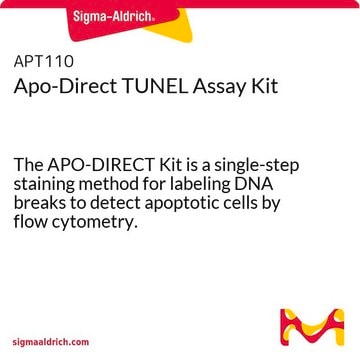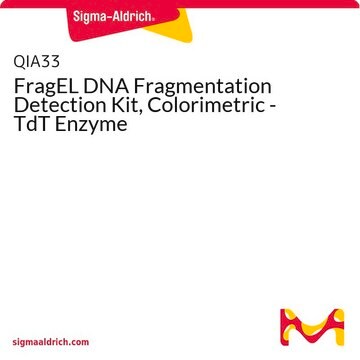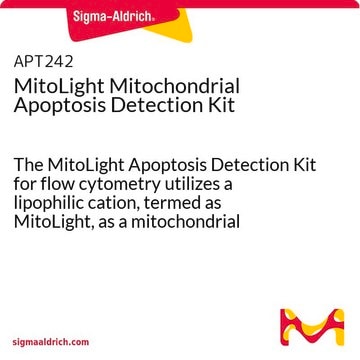S7100
Kit ApopTag Peroxidase per il rilevamento dell′apoptosi in situ
The ApopTag Peroxidase In Situ Apoptosis Detection Kit detects apoptotic cells in situ by labeling & detecting DNA strand breaks by the TUNEL method.
Sinonimo/i:
ApopTag Kit, In Situ Apoptosis Detection Kit
About This Item
Prodotti consigliati
Livello qualitativo
Produttore/marchio commerciale
ApopTag
Chemicon®
Metodo di rivelazione
colorimetric
Condizioni di spedizione
dry ice
Descrizione generale
Of all the aspects of apoptosis, the defining characteristic is a complete change in cellular morphology. As observed by electron microscopy, the cell undergoes shrinkage, chromatin margination, membrane blebbing, nuclear condensation and then segmentation, and division into apoptotic bodies which may be phagocytosed (11, 19, 24). The characteristic apoptotic bodies are short-lived and minute, and can resemble other cellular constituents when viewed by brightfield microscopy. DNA fragmentation in apoptotic cells is followed by cell death and removal from the tissue, usually within several hours (7). A rate of tissue regression as rapid as 25% per day can result from apparent apoptosis in only 2-3% of the cells at any one time (6). Thus, the quantitative measurement of an apoptotic index by morphology alone can be difficult.
DNA fragmentation is usually associated with ultrastructural changes in cellular morphology in apoptosis (26, 38). In a number of well-researched model systems, large fragments of 300 kb and 50 kb are first produced by endonucleolytic degradation of higher-order chromatin structural organization. These large DNA fragments are visible on pulsed-field electrophoresis gels (5, 43, 44). In most models, the activation of Ca2+- and Mg2+-dependent endonuclease activity further shortens the fragments by cleaving the DNA at linker sites between nucleosomes (3). The ultimate DNA fragments are multimers of about 180 bp nucleosomal units. These multimers appear as the familiar "DNA ladder" seen on standard agarose electrophoresis gels of DNA extracted from many kinds of apoptotic cells (e.g. 3, 7,13, 35, 44).
Another method for examining apoptosis via DNA fragmentation is by the TUNEL assay, (13) which is the basis of ApopTag technology. The DNA strand breaks are detected by enzymatically labeling the free 3′-OH termini with modified nucleotides. These new DNA ends that are generated upon DNA fragmentation are typically localized in morphologically identifiable nuclei and apoptotic bodies. In contrast, normal or proliferative nuclei, which have relatively insignificant numbers of DNA 3′-OH ends, usually do not stain with the kit. ApopTag Kits detect single-stranded (25) and double-stranded breaks associated with apoptosis. Drug-induced DNA damage is not identified by the TUNEL assay unless it is coupled to the apoptotic response (8). In addition, this technique can detect early-stage apoptosis in systems where chromatin condensation has begun and strand breaks are fewer, even before the nucleus undergoes major morphological changes (4, 8).
Apoptosis is distinct from accidental cell death (necrosis). Numerous morphological and biochemical differences that distinguish apoptotic from necrotic cell death are summarized in the following table (adapted with permission from reference 39).
Componenti
Tampone di reazione 2,0 mL tra -15 °C e -25 °C
Enzima TdT 0,64 mL tra -15 °C e -25 °C
Tampone di arresto/lavaggio 20 mL tra -15 °C e -25 °C
Anti-digossigenina-perossidasi* 3,0 mL tra 2 °C e 8 °C
Vetrini coprioggetto in plastica 100 per conf. Temp. ambiente
Nota: è necessario acquistare separatamente la DAB (substrato della perossidasi). Non viene fornita con il kit.
Numeri di campioni per kit: i materiali forniti sono sufficienti per colorare 40 campioni di tessuto di circa 5 mm2 ciascuno, se usati seguendo le istruzioni. Se si usano i kit per campioni montati su vetrini, il tampone di reazione si esaurisce prima degli altri reagenti.
Stoccaggio e stabilità
Precauzioni
1. I seguenti componenti del kit contengono cacodilato di potassio (acido dimetilarsinico) come tampone: Tampone di equilibrazione (90416), Tampone di reazione (90417) ed Enzima TdT (90418). Questi componenti sono nocivi se ingeriti; evitare il contatto con la cute e gli occhi (indossare guanti e occhiali) e lavare immediatamente le superfici di contatto.
2. I coniugati di anticorpi (90420) e le soluzioni di bloccaggio (n. 10 e n. 13) contengono 0,08% di sodio azide come conservante.
3. L′Enzima TdT (90418) contiene glicerolo e non congela a -20 °C. Per ottimizzare la durata di conservazione non scaldare il reagente a temperatura ambiente prima di erogarlo.
Note legali
Avvertenze
Danger
Indicazioni di pericolo
Consigli di prudenza
Classi di pericolo
Aquatic Chronic 2 - Carc. 1B - Skin Sens. 1 - STOT RE 2 Inhalation
Organi bersaglio
Respiratory Tract
Codice della classe di stoccaggio
6.1C - Combustible acute toxic Cat.3 / toxic compounds or compounds which causing chronic effects
Certificati d'analisi (COA)
Cerca il Certificati d'analisi (COA) digitando il numero di lotto/batch corrispondente. I numeri di lotto o di batch sono stampati sull'etichetta dei prodotti dopo la parola ‘Lotto’ o ‘Batch’.
Possiedi già questo prodotto?
I documenti relativi ai prodotti acquistati recentemente sono disponibili nell’Archivio dei documenti.
I clienti hanno visto anche
Articoli
Cellular apoptosis assays to detect programmed cell death using Annexin V, Caspase and TUNEL DNA fragmentation assays.
Il team dei nostri ricercatori vanta grande esperienza in tutte le aree della ricerca quali Life Science, scienza dei materiali, sintesi chimica, cromatografia, discipline analitiche, ecc..
Contatta l'Assistenza Tecnica.















